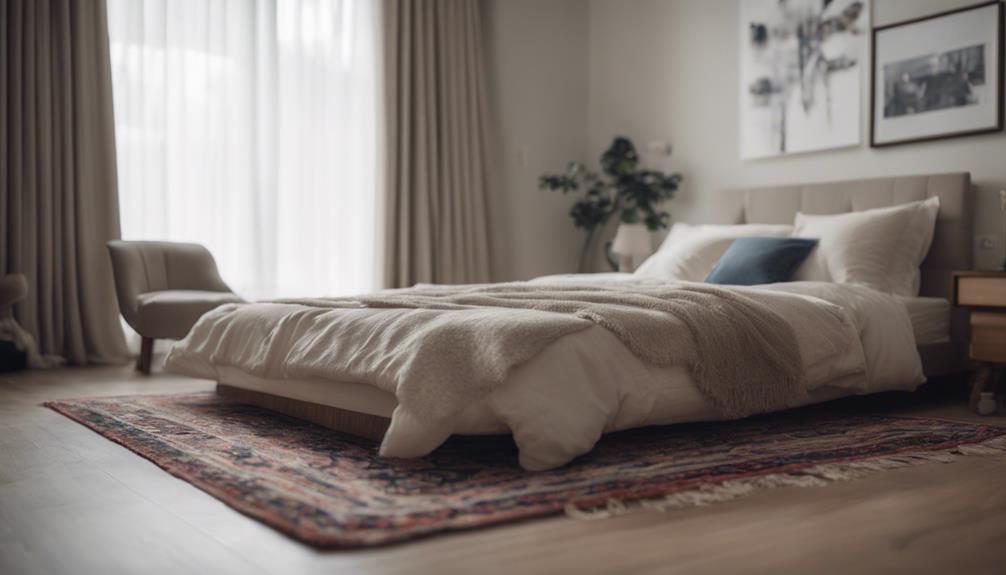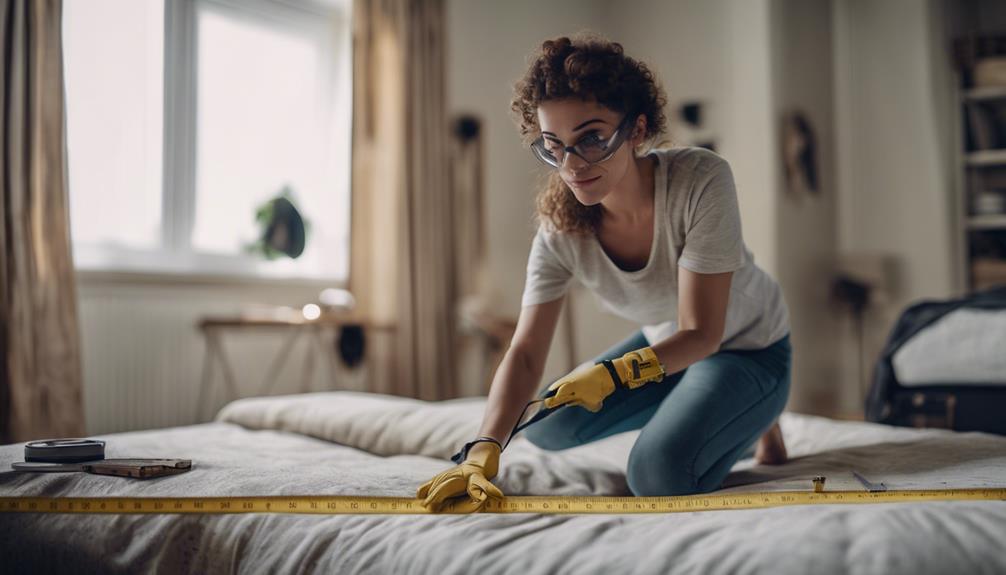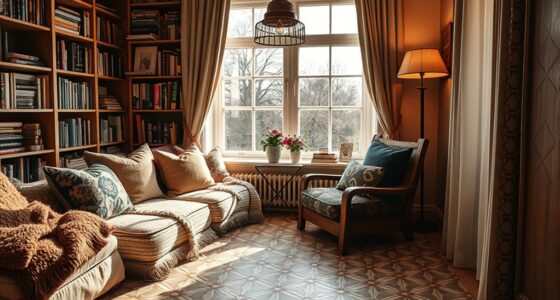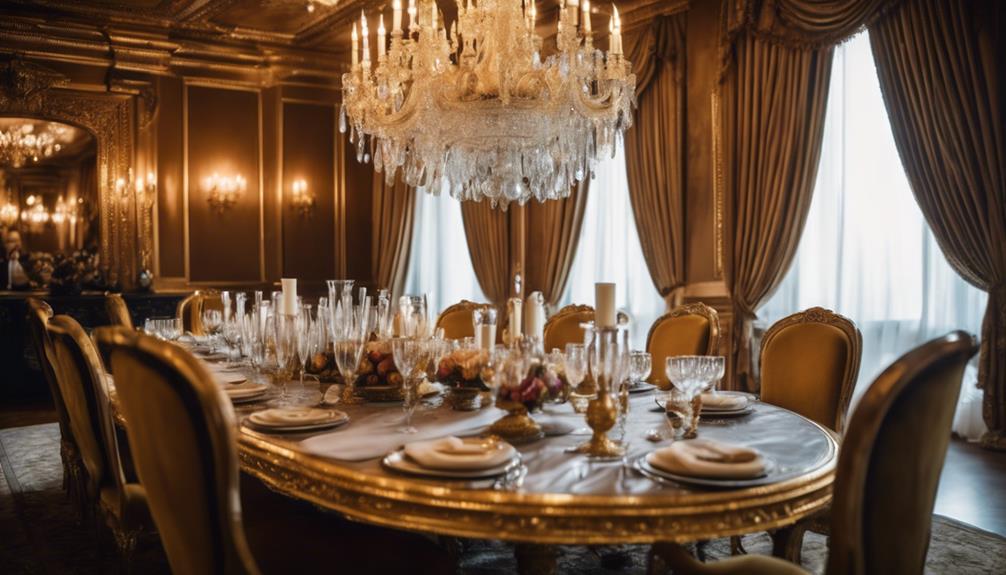You might not know it, but your bedroom's lighting can affect your sleep. To fix this mistake, try using various light sources like lamps and sconces for coziness. Opt for floor-to-ceiling curtains to enhance warmth and style. Embrace minimal decor to declutter and relax your space. Minimize clutter and choose the right rug size for a balanced look. Leave space around your bed for easy movement and consider DIY projects for safety. Plan your budget wisely to avoid overspending. Improve your bedroom environment for better sleep with these simple fixes.
Key Takeaways
- Ensure your bedroom is clutter-free to promote relaxation and better sleep.
- Incorporate soft and cozy lighting options for a calming ambiance.
- Use floor-to-ceiling curtains for warmth, style, and improved sleep quality.
- Opt for a properly sized rug to enhance comfort and visual appeal.
- Leave adequate space around your bed for easy movement and a spacious feel.
Lighting: Multiple Sources for Coziness
To create a cozy and inviting atmosphere in your bedroom, incorporate multiple sources of lighting, such as lamps, wall sconces, and pendant lights.
Don't settle for just one overhead light; try something different by layering various lighting options throughout the room.
Make sure to include dimmable lights to adjust the ambiance according to your mood and to create a relaxing environment before bedtime.
Adding a little bit of creativity with twinkle lights or crown molding lighting can bring warmth and charm to your bedroom.
By using different sources of lighting, you can eliminate harsh shadows and create a soothing and comfortable space for relaxation.
Curtains: Length and Warmth

You want your bedroom to feel warm and inviting, right? Well, choosing the right length curtains can make a big difference.
Opt for floor-to-ceiling drapes to add that cozy touch and enhance the ambiance of your space.
Make sure to pick curtains that bring warmth and style to your bedroom for a better night's sleep.
Curtain Length Importance
Consider opting for floor-to-ceiling length drapes in your bedroom to enhance warmth and coziness. When it comes to curtain length, getting it right can make a significant difference in both the aesthetics and comfort of your room. Here's why choosing the correct curtain length is essential:
- Enhanced Elegance:
Curtains that reach almost to the ceiling and floor can elevate the overall grandeur of your space, making it feel more luxurious and visually appealing.
- Improved Insulation:
Longer curtains not only add a touch of elegance but also provide better sound dampening and insulation. This extra layer helps in creating a peaceful and cozy environment, ideal for a restful night's sleep.
- Polished Look:
DIY or purchasing curtains of the correct length can prevent a drafty or unfinished appearance, ensuring your home decor looks cohesive and well put together.
Cozy Warmth With Drapes
For a cozy and warm ambiance in your bedroom, opt for floor-to-ceiling length drapes that enhance comfort and insulation. Not only do these curtains add a touch of elegance, but they also provide practical benefits like sound dampening and heat retention. Choosing curtains that almost touch the ceiling and floor can create a grand and snug feeling, perfect for creating a relaxing environment to unwind in.
Consider the following table to guide you in selecting the ideal drapes for your bedroom:
| Curtain Length | Warmth Level | Aesthetic Appeal |
|---|---|---|
| Floor-to-ceiling | High | Elegant and cozy |
| Below window sill | Medium | Casual and airy |
| Above floor level | Low | Modern and minimalistic |
Enhancing Room Ambiance
To create a cozy and inviting atmosphere in your bedroom, focus on selecting the right curtain length and warmth level to enhance the overall room ambiance. Here are some tips to help you achieve the perfect look:
- Floor-to-Ceiling Drapes: Opt for curtains that reach almost to the ceiling and floor. This not only adds warmth but also provides sound dampening qualities, making your room feel more intimate and peaceful.
- Cozy and Grand Feeling: Choosing curtains that are nearly floor-to-ceiling can give your space a cozy and grand ambiance. The added fabric creates a sense of luxury and comfort, perfect for winding down at the end of the day.
- Visual Appeal and Functionality: Consider curtains as both a decorative and functional element in your bedroom. Look for options that not only enhance the room's aesthetic but also contribute to a soothing and restful environment by reducing outside noise and controlling light levels.
Decor: Minimalism for Relaxation

Creating a minimalist decor in your bedroom can greatly enhance relaxation by reducing visual clutter and fostering a peaceful environment. Minimalism focuses on essential items, decluttering the space for better rest and relaxation. By keeping decor minimal, you can create a soothing space that enhances your overall well-being. Minimalist design in the bedroom helps to minimize distractions and promotes a sense of calm for better sleep. Embracing minimalism in your bedroom decor can lead to a more serene and tranquil atmosphere, perfect for unwinding after a long day.
| Benefits of Minimalist Decor in the Bedroom |
|---|
| 1. Reduces visual clutter |
| 2. Creates a peaceful environment |
| 3. Enhances overall well-being |
| 4. Minimizes distractions |
| 5. Promotes a sense of calm for better sleep |
Clutter: Minimize for Serenity

Minimizing clutter in your bedroom is key to promoting serenity and reducing stress levels, ultimately fostering a relaxing environment conducive to unwinding and better sleep quality. A clutter-free space allows you to clear your mind and focus on rest, creating a peaceful sanctuary to retreat to after a long day.
To achieve this tranquil atmosphere, consider the following:
- Storage Solutions: Utilize under-bed storage bins, closet organizers, or shelves to keep items organized and out of sight. This not only frees up physical space but also declutters your mind.
- Minimal Decor: Opt for a minimalist approach to decor. Limiting the number of objects in your bedroom reduces visual distractions, helping you unwind more easily and promoting a sense of calm.
- Regular Decluttering: Make decluttering a habit. Regularly assess your belongings and donate or discard items you no longer need. This practice will prevent clutter from accumulating and maintain a serene environment in your bedroom.
Rugs: Size and Functionality

When it comes to rugs in your bedroom, size matters. Make sure to choose a rug that surrounds your bed adequately for both visual appeal and functionality.
The right rug size can anchor your bed in the room without overpowering the space.
Rug Size Guidelines
To guarantee your bedroom design is visually balanced and cozy, choose a rug size that extends about 24 to 28 inches around your bed. This not only creates a pleasant aesthetic but also adds functionality to the space by providing a soft landing for your feet when you get out of bed.
Here are some guidelines to help you select the right rug size for your bedroom:
- Anchor the Bed: A rug that properly anchors the bed in the room helps tie the design elements together and creates a cohesive look.
- Avoid Small Rugs: Opting for a rug that's too small under the bed can throw off the visual balance of the room, making it appear disjointed and cluttered.
- Budget-Friendly Alternatives: Consider using runners on either side of the bed if a larger rug isn't feasible. This cost-effective solution can still add warmth and style to your bedroom while keeping within your budget.
Functional Rug Placement
For optimal functionality and visual appeal in your bedroom, make certain the rug extends approximately 24 to 28 inches around your bed. Proper rug placement not only defines the sleeping area but also adds warmth and style to your space.
Choosing a rug size that anchors the bed in the room is key to creating a cohesive and balanced look. Rugs that are too small under the bed can disrupt the flow of the room and make it feel visually off-kilter.
To frame the sleeping area cost-effectively, consider using runners on either side of the bed. By selecting the right rug size, you guarantee that the bed fits well within the room without overwhelming the space. This promotes a harmonious bedroom design that's both functional and visually pleasing.
Bed: Balance and Space

Confirm your bed size complements the dimensions of your bedroom to maintain a balanced and spacious layout. Ensuring the right balance and space around your bed is essential for a comfortable and visually appealing bedroom.
Here are some tips to help you achieve a harmonious setup:
- Space Around the Bed: Leave at least 2 feet of space around your bed to facilitate easy movement and access. This will prevent your room from feeling cramped and allow for a more open and airy atmosphere.
- Bed Size vs. Room Size: Balance the size of your bed with the dimensions of your bedroom to avoid overcrowding. Choosing a bed that fits comfortably in the room without overpowering the space will create a more inviting environment.
- Symmetry and Functionality: Opt for a bed size that allows for two nightstands. This symmetrical layout not only enhances the visual balance of the room but also adds functionality to your bedside area.
DIY: Accurate Measurements and Safety

Precise measurements and prioritizing safety are fundamental aspects of any DIY project, securing successful and safe outcomes. When initiating a DIY task, taking exact measurements is crucial to avoid costly mistakes like cutting materials too short or long. Using the appropriate tools for the job not only guarantees effective results but also minimizes safety hazards.
Always give priority to safety by wearing suitable protective gear and following instructions to prevent injuries during the project.
Furthermore, thorough planning is essential to the success of any DIY venture. Rushing through a project without sufficient preparation can lead to errors and below-par outcomes. Remember to allocate adequate time for each step and follow a systematic approach to achieve the desired results.
Before painting, make certain to sand and prime surfaces properly to achieve a smooth finish and long-lasting effects. By focusing on precise measurements, safety precautions, and meticulous planning, you can elevate your DIY projects to new heights.
Budget: Plan and Avoid Overspending

When managing your bedroom project, ensuring a well-planned budget is key to avoiding overspending and maximizing your resources. Follow these steps to keep your bedroom makeover on track:
- Create a detailed budget: List all necessary items for the project and allocate a specific budget for each aspect of the bedroom design. This will help you stay organized and prevent overspending.
- Research and compare prices: Look for affordable options without compromising quality. Compare prices from different stores or online retailers to find the best deals on furniture, decor, and other essentials.
- Consider DIY and repurposing: Save money by exploring do-it-yourself options or repurposing items you already own. Get creative with decor ideas to give your bedroom a unique touch while staying within budget.
Frequently Asked Questions
How to Fix up Your Bedroom?
To fix up your bedroom, add various lighting sources for ambiance, use floor-to-ceiling drapes for coziness, keep decor minimal, choose a rug that frames the bed, and guarantee your bed size fits the room with space for two nightstands.
How Often Should You Change Your Bedroom?
A clean bedroom is essential for good health and sleep quality. Change your bedding every 1-2 weeks and wash mattress covers every 1-3 months. Regular vacuuming and sunning pillows can help maintain freshness and hygiene.
How Do You Fix a Boring Bedroom?
To fix a boring bedroom, add various lighting sources like lamps and sconces, opt for dimmable options, use floor-to-ceiling drapes for coziness, keep decor minimal, and choose a rug that anchors the bed. Redefine your space for ultimate relaxation.
How Do I Make My Bedroom Feel Complete?
To make your bedroom feel complete, add various lighting sources, like lamps and sconces, for a cozy vibe. Hang floor-to-ceiling drapes for warmth and sound dampening. Keep decor minimal, store items away, choose a rug that anchors the bed, and select a bed size that fits the room.
Conclusion
Now that you know the common bedroom mistakes to avoid, it's time to transform your sanctuary.
Remember, your bedroom should be a peaceful oasis, like a gentle breeze on a warm summer day.
By incorporating multiple lighting sources, cozy curtains, minimal decor, and decluttering, you can create a space that promotes relaxation and rejuvenation.
So, roll up your sleeves, grab a tape measure, and get ready to make your bedroom a haven of tranquility.









